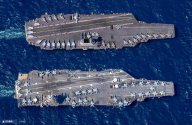You are using an out of date browser. It may not display this or other websites correctly.
You should upgrade or use an alternative browser.
You should upgrade or use an alternative browser.
CV-18 Fujian/003 CATOBAR carrier thread
- Thread starter Jeff Head
- Start date
Can we confirm that KJ-600 has landed?Or is this just an optical illusion of the helicopter?View attachment 162301
Who knows.
Even if KJ-600 has landed on Fujian, it's not a big deal because we know they've already done aviation trials of KJ-600 on it and they had at least three airframes on the ship simultaneously.
At this point it should be normal/not a huge surprise if they're doing regular aviation trials on Fujian.
Fujian allegedly returned to port yesterday with some planes on board.






Can we confirm that KJ-600 has landed?Or is this just an optical illusion of the helicopter?View attachment 162301
It looks indeed like one, but do we know if this image is recent?
PS. Seems so according to @00CuriousObserver‘s Post
CV-18 Fujian Sea Trials
CV-18 Fujian First Sea Trial (1 may 2024 - 8 may 2024) (8 days)
CV-18 Fujian Second Sea Trial (23 may 2024 - 11 june 2024) (18 days)
CV-18 Fujian Third Sea Trial (3 july 2024 - 28 july 2024) (25 days)
CV-18 Fujian Fourth Sea Trial (3 september 2024 - 21 september 2024) (18 days)
CV-18 Fujian Fifth Sea Trial (18 november 2024 - 3 december 2024) (15 days)
CV-18 Fujian Sixth Sea Trial (28 december 2024 - 7 january 2025) (11 days)
CV-18 Fujian Seventh Sea Trial (18 march 2025 - 1 april 2025) (14 days)
CV-18 Fujian Eighth Sea Trial (21 may 2025 - 27 may 2025) (7 days)
CV-18 Fujian Ninth Sea Trial (10 september 2025 - 30 september 2025) (20 days)
CV-18 Fujian Tenth Sea Trial (3 october 2025 - 10 october 2025) (7 days)
Total 143 days at sea
CV-18 Fujian First Sea Trial (1 may 2024 - 8 may 2024) (8 days)
CV-18 Fujian Second Sea Trial (23 may 2024 - 11 june 2024) (18 days)
CV-18 Fujian Third Sea Trial (3 july 2024 - 28 july 2024) (25 days)
CV-18 Fujian Fourth Sea Trial (3 september 2024 - 21 september 2024) (18 days)
CV-18 Fujian Fifth Sea Trial (18 november 2024 - 3 december 2024) (15 days)
CV-18 Fujian Sixth Sea Trial (28 december 2024 - 7 january 2025) (11 days)
CV-18 Fujian Seventh Sea Trial (18 march 2025 - 1 april 2025) (14 days)
CV-18 Fujian Eighth Sea Trial (21 may 2025 - 27 may 2025) (7 days)
CV-18 Fujian Ninth Sea Trial (10 september 2025 - 30 september 2025) (20 days)
CV-18 Fujian Tenth Sea Trial (3 october 2025 - 10 october 2025) (7 days)
Total 143 days at sea
There's significant psychological difference in how land and carrier combat pilots training is approached. It takes root since before ww2.All of which is a long way of saying, I suspect the current/recent existing J-15/T pilot cadre is probably already disproportionately oversized for what would be needed for CV-16/17 if they were doing "regular frontline combat duties" most of the time (which for the last few years they've spent most of their time doing training and working up as many pilots and crews as possible, while only occasionally doing frontline combat duty/patrols).
For ground pilots, air power comes as a separate entity: pilots will usually fight over "3rd bodies" most of the time, and even when they fight over actual airfields(theirs or enemy's) - the most important thing, almost universally, is air power's survival.
They will have a place to return to, they will be rescued on a "best effort possible" basis.
For naval pilots, all this logic goes down the window.
Carrier aviation exists as long as there are carriers. Damaged carrier means that no matter how well you preserved your plane - your aircraft is probably lost, and there's a good chance in this situation CSG may fail to rescue you.
Should events go worse, it's all up to luck. No one is risking whatever remains for a pilot. This of course goes both ways - no matter what happened in the air, shall enemy carrier be disabled - c'est la vie, sharks will have their breakfast.
And it means, that in a pitch, carrier pilots (maritime pilots in general, if they're trained as such first and foremost) are expected to chose the riskiest option and press down. This normally resulted in carrier air engagements being desperate: dozens of planes in minutes, with loss rates going from dozens of percents to 100% for both sides. Rare exceptions and great successes for land-based airfights, norm for all carrier battles.
"Biting some and backing off" doesn't really work for pilots - but it certainly works best for carriers themselves. Carrier is floaty bomb with excellent speed and stand off, and it's very hard to replace - it makes all sense for it to operate cautiously.
As such, carrier pilots, elite as they are, don't really have high life expecancy in contested combat - especially since you can't really have their training time cut and expect anything from them. Carrier pilot first wastes a lot of time - enough to have a good single task pilot! - just learning landings, and on top, after that, only then his flight hours go into something actually fighty.
Otherwise - accidents on the deck can functionally disable carrier no worse than ASCM hits.
Weapons may have changed compared to WW2, but basic logic as such didn't. This is why, if carrier is prepared for possible war, there's no such thing as too much airwings.
Worst thing possible - you'll have overtrained pilots fighting from land(like famous IJN Tainan airgroup). But it's normal for fleet staff to overtrain personnel - chance carriers will change multiple airgroups is high.
It isn't special sign of "training versus deployments"; i fully expect CV3, 4 etc to do the exact same thing.
Americans don't do it currently for two main reasons: 1, they don't yet expect such warfare(probably already should) - as since 1944, there was just no such navy to truly fight desparately against. Soviet navy wasn't carrier navy, logic of engagements against it wasn't "desparate"(in fact, it was the worst possible thing to do).
2, they have the cadre anyways - just because of doing the same thing for better half of the century, nonstop.
CV-18 Fujian Sea Trials
CV-18 Fujian First Sea Trial (1 may 2024 - 8 may 2024) (8 days)
CV-18 Fujian Second Sea Trial (23 may 2024 - 11 june 2024) (18 days)
CV-18 Fujian Third Sea Trial (3 july 2024 - 28 july 2024) (25 days)
CV-18 Fujian Fourth Sea Trial (3 september 2024 - 21 september 2024) (18 days)
CV-18 Fujian Fifth Sea Trial (18 november 2024 - 3 december 2024) (15 days)
CV-18 Fujian Sixth Sea Trial (28 december 2024 - 7 january 2025) (11 days)
CV-18 Fujian Seventh Sea Trial (18 march 2025 - 1 april 2025) (14 days)
CV-18 Fujian Eighth Sea Trial (21 may 2025 - 27 may 2025) (7 days)
CV-18 Fujian Ninth Sea Trial (10 september 2025 - 30 september 2025) (20 days)
CV-18 Fujian Tenth Sea Trial (3 october 2025 - 10 october 2025) (7 days)
Total 143 days at sea

Bagu article revealed that first EMAL launch occurred in March of this year.
“March” has been removedView attachment 162351
Bagu article revealed that first EMAL launch occurred in March of this year.





